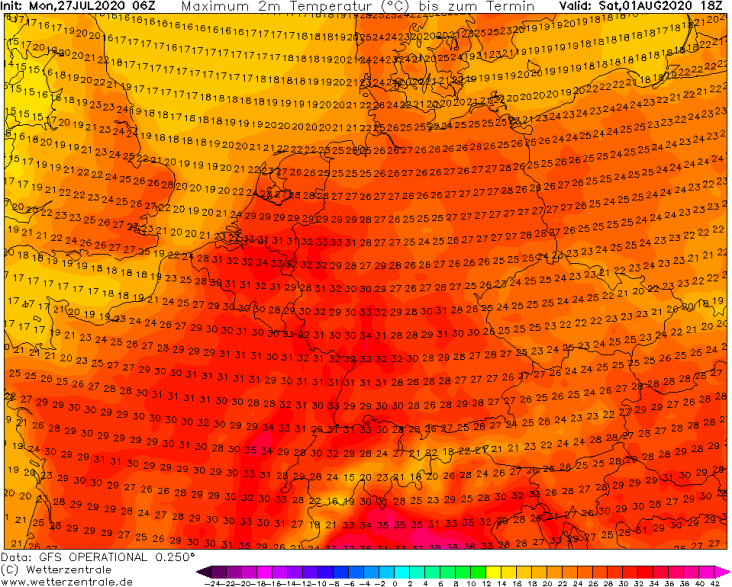Op wetterzentrale is de nieuwe parallel van GFS weer te vinden, deze zal over een periode de huidige oper weer gaan vervangen. De para run is nog in ontwikkeling. Dit is een mooi moment om eens te kijken naar de werking van de parallel, nu die nog niet helemaal vlekkeloos gaat.
Vooral de temperaturen werken nog slecht. In het model warmt het overdag te snel op, dus parameters als bodemvocht of plantenbedekking zouden bijvoorbeeld nog een slechte benadering van de realiteit geven.


40°C in Parijs volgens de parallel, terwijl de huidige GFS oper nog gaat voor 36°C. GFS oper geeft lokaal in Frankrijk nog 37 - 39°C.
In Nederland zien we in de huidige GFS oper 23 tot 30°C, de warmte stroomt binnen.


In het zuidoosten 36-38°C in de parallel, terwijl de GFS oper maximaal 33°C in de Kempen weergeeft. Ook hier heeft de parallel een grote overschatting van de maximumtemperatuur.
GFS wordt dus vernieuwd, ze verwachten dat rond januari 2021 de parallel klaar is om de oper te vervangen en zelf de nieuwe oper te worden. Momenteel is de parallel nog niet bruikbaar bij verwachtingen, de temperaturen zijn nog niet volledig realistisch.
| Gewijzigd: 27 juli 2020, 17:43 uur, door Thijs.Plannen van NOAA:
Goals for the new model are:
- a unified system to improve forecast accuracy beyond 8 to 10 days
- better model forecasts of hurricane track and intensity, and
- the extension of weather forecasting through 14 days and for extreme events, 3 to 4 weeks in advance.
Engaging the meteorology community during model development and improvement is a priority for NOAA. The agency plans to develop a program to involve researchers in testing and improving algorithms, data assimilation methods and physics. The goal is to incorporate successful enhancements into operations.
With the initial operational implementation of FV3GFS now accomplished, EMC's global modeling focus will turn towards development of the next GFS (v16) upgrade, which is expected to include increased vertical resolution, more advanced physics, data assimilation system upgrades, and coupling to a wave model. Implementation of GFSv16 is targeted for the winter of 2021.
Concurrently, a collaborative effort between EMC, ESRL/GSD, NSSL, and GFDL is underway to develop and test a FV3 standalone regional model (FV3-SAR) at convective-allowing model (CAM) horizontal resolution of ~3 km. EMC's short-term goal is to replace the NEMS-NMMB member of the operational High-Resolution Ensemble Forecast (HREF) system with an FV3-SAR member, tentatively in the fall of 2020. The long-term goal is to replace NCEP’s current suite of high-resolution guidance (HRRR, HREF, NAM nests) with an FV3-based Rapid Refresh Forecast System (RRFS) by 2023.

 GFS heeft nieuwe parallel
GFS heeft nieuwe parallel




